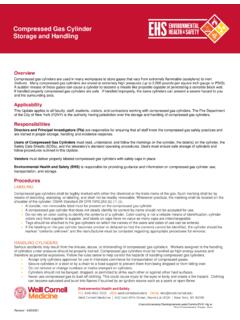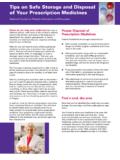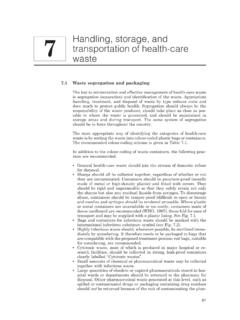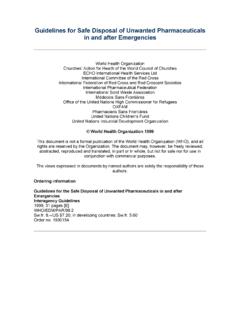Transcription of Waste Disposal Procedures - Cornell University
1 DATE REVIEWED: August 27, 2020 DATE UPDATED: August 25, 2020 CLASSIFICATION & LOCATION: Hazardous Waste T:\Documentation\EHS-Manual\ PAGE: 1 of 73 Waste Disposal Procedures (EHS Program Manual ) Overview Weill Cornell Medicine research, clinical, service, maintenance, and cleaning operations generate several types of Waste (chemical, biological, radioactive, universal, and recyclable). Waste must be adequately managed by personnel ( generators ) in their work areas prior to collection and/or Disposal . Environmental Health and Safety (EHS) at Weill Cornell Medicine (WCM) has developed this Waste Disposal Program Manual to instruct generators in the proper management of chemical, biological, and universal wastes. The Office of Health Physics manages and provides guidance on the Disposal of radioactive wastes. Special consideration must be taken when wastes consist of mixtures of chemical, biological, and/or radiological materials ( mixed wastes ).
2 Generators must ensure these mixed wastes are correctly assessed, managed and disposed of as required by the chemical, biological, and radiological Waste management Procedures . Table of Contents 1 Table of Contents .. 1 Objectives .. 4 Applicability .. 5 Responsibilities .. 5 Waste GENERATORS .. 5 ENVIRONMENTAL HEALTH AND SAFETY (EHS) .. 5 HOUSEKEEPING .. 5 Chemical/Hazardous Waste Management .. 5 SPECIFIC CHEMICAL Waste Disposal Procedures .. 6 HAZARDOUS Waste Disposal Procedures .. 6 CHEMICAL Waste SATELLITE ACCUMULATION AREA (CWSAA) REQUIREMENTS .. 7 CWSAA Posters .. 7 CWSAA Location .. 7 CWSAA storage Limits .. 8 CHEMICAL Waste SELF-AUDIT 8 CHEMICAL Waste DEFINITIONS .. 8 Characteristic Hazardous 8 Listed Hazardous Waste .. 8 Stock Chemical .. 8 Biological/Regulated Medical Waste Management .. 9 SPECIFIC BIOLOGICAL Waste Disposal Procedures .
3 9 REGULATED MEDICAL Waste Disposal 9 BIOLOGICAL DECONTAMINATION Procedures .. 10 Bleach Disinfection of Biosafety Level 1 and 2 Liquid Waste .. 10 Autoclaving Procedures for Biosafety Level (BSL) 1 and 2 Liquid Waste .. 11 Personal Protective Equipment (PPE) .. 11 Restrictions on Autoclave Use .. 11 Autoclave Procedure .. 11 BIOLOGICAL Waste DEFINITIONS .. 12 DATE REVIEWED: August 25, 2020 DATE UPDATED: August 27, 2020 CLASSIFICATION & LOCATION: Hazardous Waste T:\Documentation\EHS-Manual\ PAGE: 2 of 73 CONTINUED: Waste Disposal Procedures Animal Waste .. 12 Cultures and Stocks .. 12 Decontamination .. 12 Human Pathological Waste .. 12 Human Blood and Blood Products .. 12 Infectious Agent .. 12 Isolation Wastes .. 13 Recombinant and Synthetic Nucleic Acids .. 13 Sharps .. 13 Radioactive Waste Disposal Procedures .
4 13 Waste MINIMIZATION .. 13 Waste CONTAINERS AND LABELING .. 14 Containers for Dry Activated Waste (DAW) .. 16 Containers for Sharps .. 16 Containers for Bulk Liquid Collection and Secondary Containment .. 16 Containers for Liquid Scintillation Vials .. 16 Containment of Animal Carcasses .. 16 Waste SEGREGATION AND ACCUMULATION .. 17 Dry Activated Waste (DAW) .. 17 Liquid Waste .. 17 Liquid Scintillation Vials .. 17 Bulk Liquid Scintillation Fluids (LSB).. 18 Radioactive Sharps .. 19 OTHER RADIOACTIVE Waste .. 20 Animal Materials .. 20 Metallic Lead (Uncontaminated) .. 20 Tritium (H3) Exit Signs and Smoke Detectors .. 20 Uranium/Thorium Compounds .. 20 Sealed Sources .. 21 Liquid Scintillation Counters and Electron Capture Gas Chromatographs .. 21 Waste REMOVAL .. 21 Decay in storage .. 21 EHS Waste Collection.
5 21 DEFINITIONS .. 21 Dry Activated Waste (DAW) for Incineration .. 21 Radioactive Biohazardous Waste .. 22 Radioactive Hazardous Sharps Waste .. 22 Radioactive Non-Biohazardous Sharps Waste .. 22 Radioactive Regulated Medical Waste .. 22 Radioactive Liquid Waste .. 22 Radioactive Mixed Waste .. 22 Radioactive Stock Vials .. 23 Clinical, Biological, and Chemical Waste Management .. 23 CLINICAL RED BAG Waste .. 23 Acceptable Red Bag Contents .. 23 Disposal Procedures .. 23 Packaging/Shipping Procedures .. 23 CLINICAL SHARPS Waste .. 24 Acceptable Sharps Waste Contents .. 24 DATE REVIEWED: August 25, 2020 DATE UPDATED: August 27, 2020 CLASSIFICATION & LOCATION: Hazardous Waste T:\Documentation\EHS-Manual\ PAGE: 3 of 73 CONTINUED: Waste Disposal Procedures Disposal Procedures .. 24 Packaging/Shipping Procedures .
6 24 CLINICAL CHEMOTHERAPEUTIC Waste .. 25 EPA-Regulated Chemotherapeutic Agents List .. 25 EPA-Regulated Chemotherapeutic Waste Managed by EHS .. 25 All Other Chemotherapeutic Waste Managed via Stericycle .. 26 CLINICAL CHEMICAL Waste .. 27 Reverse Distribution .. 27 Empty Containers and Vials .. 27 Non-Hazardous Chemical Waste .. 28 Hazardous Clinical Chemical Waste .. 28 CLINICAL Waste DEFINITIONS .. 29 Acutely Toxic Chemicals .. 29 Chemotherapeutic Sharps Wastes .. 29 Chemotherapeutic Clinical Trial Samples .. 29 EPA-Regulated Chemotherapeutic Agents .. 29 Clear Bag Waste /Trash .. 29 Clinical Drug and Chemical Wastes .. 29 Human Blood and Blood Products .. 30 Non-Hazardous Chemical Wastes .. 30 Red Bag Wastes .. 30 Sharps .. 30 Specific Disposal Procedures .. 30 DRAIN Disposal .. 30 Requirements for liquid Waste Disposal via a drain.
7 31 Characteristics of Liquid to Be Discarded .. 31 Drain Requirements .. 31 Procedure .. 31 Non-Hazardous Chemical Selection Criteria .. 31 TRASH Disposal (EXCLUDING EMPTY CONTAINERS) .. 32 Requirements for Trash Disposal of Contaminated Laboratory Debris .. 32 Characteristics .. 32 Procedure .. 32 EMPTY CONTAINERS .. 32 Requirements for Trash Disposal of Empty Containers .. 32 Characteristics .. 32 Procedure .. 32 RED BAG Waste .. 33 Acceptable Red Bag Contents .. 33 Disposal Procedures .. 33 SHARPS Waste .. 33 Acceptable Sharps Waste Contents .. 33 Disposal Procedures .. 34 BIOLOGICAL Waste LIQUIDS .. 34 TISSUE CULTURE VACUUM FLASK DISINFECTION AND 34 ANIMAL TISSUES .. 35 Vertebrate Animal Disposal Procedures .. 35 Invertebrate Animal Disposal Procedures .. 35 HUMAN PATHOLOGICAL Waste .. 35 DATE REVIEWED: August 25, 2020 DATE UPDATED: August 27, 2020 CLASSIFICATION & LOCATION: Hazardous Waste T:\Documentation\EHS-Manual\ PAGE: 4 of 73 CONTINUED: Waste Disposal Procedures BIOSAFETY LEVEL 3 AND SELECT AGENT Waste .
8 35 ACUTELY TOXIC CHEMICAL Waste (SHARPS AND EMPTY CONTAINERS) .. 35 Odiferous/Pungent Chemicals .. 36 ETHIDIUM BROMIDE/ELECTROPHORESIS GELS AND SOLUTIONS .. 36 Electrophoresis Gels and Contaminated Non-Sharp Debris .. 36 Contaminated 36 Stock Solutions .. 36 Spent Buffer 37 Treatment Via Adsorption for Organic Fluorescence Dyes .. 37 Treatment Via Chemical Detoxification for Ethidium Bromide Only .. 38 DEA CONTROLLED SUBSTANCES .. 38 MERCURY LAMPS AND LIGHT BULBS .. 38 Broken lamps .. 39 COMPUTERS/SURPLUS ELECTRONICS RECYCLING .. 39 Acceptable Electronics Waste .. 39 Disposal Procedures .. 40 BATTERY RECYCLING AND Disposal .. 41 Disposal Procedures .. 41 Leaking Batteries .. 41 PHOTOGRAPHIC Waste (SILVER) .. 42 Silver Recovery Processing .. 42 SCRAP LEAD RECYCLING .. 42 Scrap Lead from Radiation Shielding Materials.
9 42 Scrap Lead from Construction Projects .. 42 Disposal OF UNKNOWNS .. 43 Training .. 43 EHS SAFETY TRAINING .. 43 REGULATED MEDICAL Waste SHIPPER TRAINING .. 43 RADIOACTIVE Waste TRAINING .. 43 Record Retention, Availability, and 43 RECORD RETENTION .. 43 EHS Training 43 Medical Waste Tracking Forms .. 44 PROGRAM REVISIONS .. 44 References .. 44 FEDERAL .. 44 STATE .. 44 LOCAL .. 45 OTHER .. 45 EHS WEB RESOURCES .. 45 APPENDIX A Non-Hazardous Chemical List .. 46 APPENDIX B Acutely Toxic Chemical List .. 62 APPENDIX C Chemical Waste Satellite Accumulation Area Poster Sample .. 70 Appendix D Chemical Waste Self-Audit Program .. 71 Objectives This manual aims to inform and provide clear guidance to the Weill Cornell Medicine (WCM) community about the proper Disposal of chemical, biological, radiological, and universal wastes.
10 DATE REVIEWED: August 25, 2020 DATE UPDATED: August 27, 2020 CLASSIFICATION & LOCATION: Hazardous Waste T:\Documentation\EHS-Manual\ PAGE: 5 of 73 CONTINUED: Waste Disposal Procedures Applicability This procedure applies to WCM students, faculty, staff, and volunteers working at Weill Cornell who generate and dispose of the wastes identified in this procedure. Responsibilities Waste GENERATORS WCM students, faculty, staff, and volunteers who handle or use chemical, biological, radioactive, and/or universal Waste ( , batteries, computers) materials have a responsibility to ensure wastes of these materials are properly disposed of. Waste generators need to be informed and to ensure that wastes meet the following requirements: Adequately classified as chemical, biological, radiological, universal Waste , or a mixture of Waste types; Treated or decontaminated, if required; and Managed and disposed of as detailed in this procedure.










